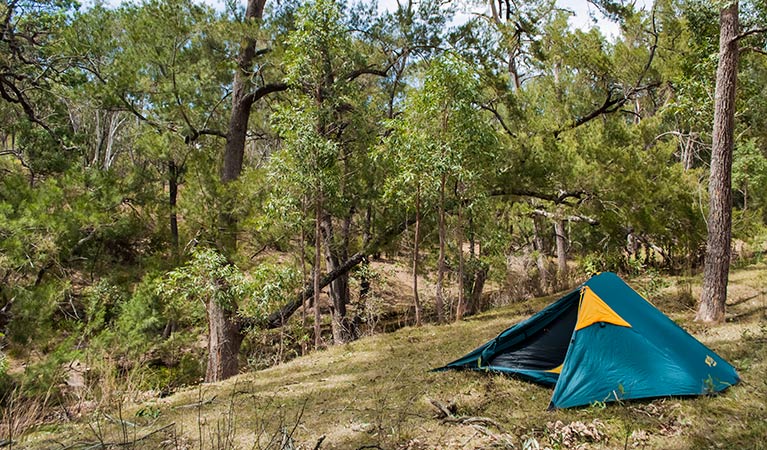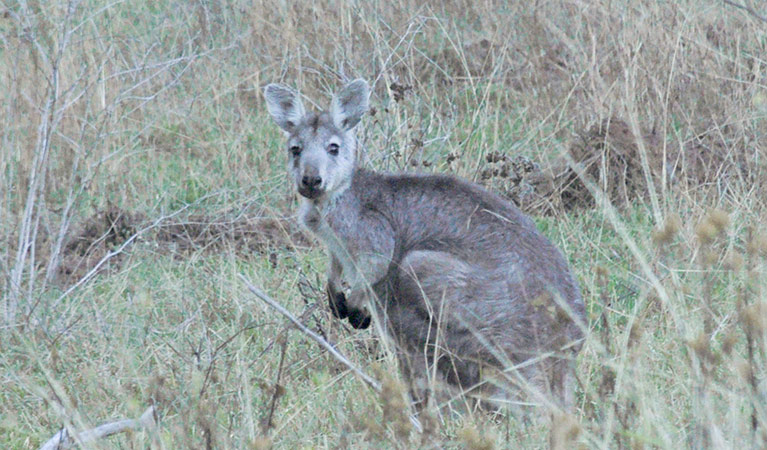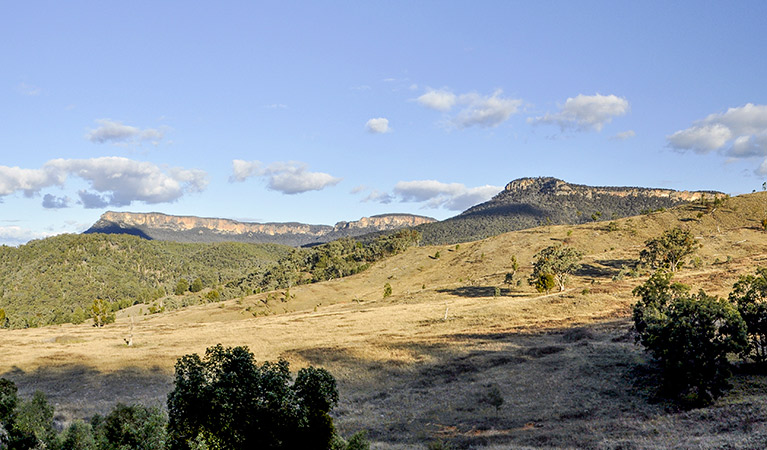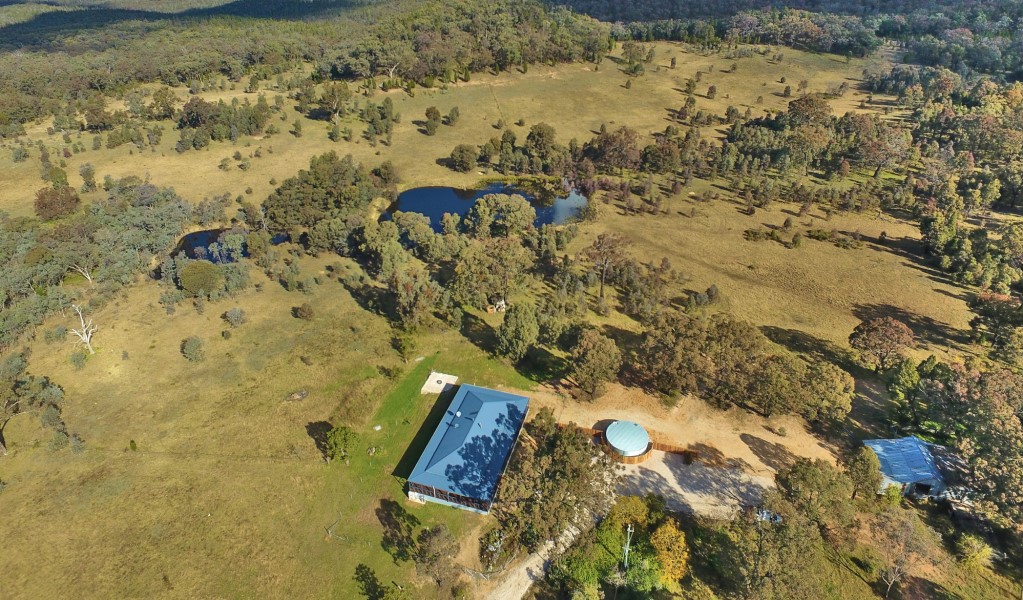Honeyeater Homestead
Capertee National Park
Overview
Get back to nature with a wilderness getaway at Honeyeater Homestead in Capertee National Park. Set west of the Blue Mountains between Lithgow and Mudgee, you’ll be surrounded by peaceful walks, spectacular views and plenty of wildlife.
| Accommodation type | Homestead |
|---|---|
| Where | 377 Port Macquarie Road, Bogee , NSW, 2849 - in Capertee National Park |
| Bedrooms | 5 |
| Maximum guests | 10 |
| Facilities | Picnic tables, barbecue facilities, carpark, showers, toilets, electric power, balcony, outdoor furniture, kitchen, plates and cutlery, pots and pans, bed linen, tv, towels, washing machine, rubbish bin |
| What to bring | Drinking water, cooking water, firewood, ice, shampoo and soap, hairdryer, food supplies |
| Please note |
|
Nestled on a small rise next to majestic ironbark forest, Honeyeater Homestead is the perfect place for nature lovers to relax and unwind. Located west of the Blue Mountains just an hour’s drive from Mudgee, you’ll be treated to charming country accommodation with breathtaking views of the surrounding sandstone escarpment.
After you’ve settled in, pack a picnic lunch and explore the neighbouring forest on one of the nearby trails. A 30min walk will take you to Capertee River, where you can stroll the riverbanks or enjoy a refreshing dip if the river is running. Just half an hour’s drive away, you’ll find the historic towns of Rylstone and Kandos with their heritage buildings, pubs and cosy cafes.
Make sure you pack your binoculars because you’re more than likely to spot some of the local woodland birds during your stay. If you’re lucky you may even spy the endangered regent honeyeater, for which the homestead is named.
After a day spent sightseeing, return to the quiet solitude of the homestead and soak up the afternoon sun from the wrap-around verandah.
Also see
-

Capertee Woolshed ruins
Capertee Woolshed ruins, in Capertee National Park, offer a view of the historic heritage of the area, with walking, paddling and birdwatching opportunities nearby.
-

Capertee Homestead - 'Port Macquarie'
The historic Capertee Homestead, known as 'Port Macquarie', is a great weekend getaway in Capertee National Park. Go birdwatching, mountain biking, 4WD touring and walking.
Map

Map legend

Local alerts
For the latest updates on fires, closures and other alerts in this area, see https://uat.nswparks.cloud/camping-and-accommodation/accommodation/honeyeater-homestead/local-alerts
Bookings
- National Parks Contact Centre
- 7am to 7pm daily
- 1300 072 757 (13000 PARKS) for the cost of a local call within Australia excluding mobiles
- parks.info@environment.nsw.gov.au
Operated by
- Mudgee office
- Monday to Friday, 9am to 4:30pm.
- 02 6370 9000
- npws.mudgee@environment.nsw.gov.au
- 27 Inglis Street, Mudgee NSW 2850
Park info
- in Capertee National Park in the Sydney and surrounds and Country NSW regions
Capertee National Park has a locked entry gate. If you're visiting during the day, get the gate code by calling Mudgee Office (weekdays) or Blue Mountains Heritage Centre (weekends).
Visitor info
All the practical information you need to know about Honeyeater Homestead.
Maps and downloads
Learn more
Honeyeater Homestead is in Capertee National Park. Here are just some of the reasons why this park is special:
Looking for things to do in Capertee?

There are great things to do when in Capertee. Enjoy fantastic bird watching any time of the year - the protected woodlands attract the threatened gang-gang and glossy black cockatoos, and Capertee Valley is one of only three known nesting areas for the endangered regent honeyeater. You'll find a range of options if you're looking for a place to stay, including Capertee Homestead, Cottage or campground. Bookings essential. You can also hike into remote Policemans Point campground.
- Capertee Woolshed ruins Capertee Woolshed ruins, in Capertee National Park, offer a view of the historic heritage of the area, with walking, paddling and birdwatching opportunities nearby.
- Valley lookout Relax with a picnic lunch at Valley lookout and enjoy dramatic views inside the world’s second largest canyon. It’s easily combined with a 4WD or camping getaway in Capertee National Park, near Rylstone.
Plant life abounds

The park is home to rare grey grevillea shrubs, which bloom with pink and red flowers in spring. This hardy, dense shrub is found nowhere else but Capertee Valley. Fertile river flats and surrounding slopes host an ecological community of majestic yellow box, blakelys red gum and white box, providing a vital habitat for wildlife and native birds.
- Capertee Woolshed ruins Capertee Woolshed ruins, in Capertee National Park, offer a view of the historic heritage of the area, with walking, paddling and birdwatching opportunities nearby.
- Valley lookout Relax with a picnic lunch at Valley lookout and enjoy dramatic views inside the world’s second largest canyon. It’s easily combined with a 4WD or camping getaway in Capertee National Park, near Rylstone.
Wiradjuri country

Capertee National Park is within the traditional lands of Wiradjuri People. The surrounding countryside contains evidence of Aboriginal occupation in the form of rock art, scarred trees and artefacts. Traditional food plants and old travel routes are also present within the park.
Plants and animals protected in this park
Animals
-

Regent honeyeater (Anthochaera phrygia)
The regent honeyeater is a critically endangered native bird. Once widespread across south-eastern Australia, only around 250 to 350 birds remain in the wild, making it at risk of extinction.
-

Swamp wallaby (Wallabia bicolor)
The swamp wallaby, also known as the black wallaby or black pademelon, lives in the dense understorey of rainforests, woodlands and dry sclerophyll forest along eastern Australia. This unique Australian macropod has a dark black-grey coat with a distinctive light-coloured cheek stripe.
-

Sugar glider (Petaurus breviceps)
The sugar glider is a tree-dwelling Australian native marsupial, found in tall eucalypt forests and woodlands along eastern NSW. The nocturnal sugar glider feeds on insects and birds, and satisfies its sweet tooth with nectar and pollens.
-

Bare-nosed wombat (Vombatus ursinus)
A large, squat marsupial, the Australian bare-nosed wombat is a burrowing mammal found in coastal forests and mountain ranges across NSW and Victoria. The only other remaining species of wombat in NSW, the endangered southern hairy-nosed wombat, was considered extinct until relatively recently.

